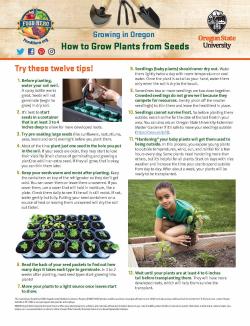Try these twelve tips!
- Before planting, water your soil well. A spray bottle works great. Seeds will not germinate (begin to grow) in dry soil.
- It’s best to start seeds in a container that is at least 3 to 4 inches deep to allow for more developed roots.
- Try pre-soaking large seeds (like sunflowers, nasturtiums, peas, beans and corn) overnight before you plant them.
- Most of the time plant just one seed in the hole you put in the soil. If your seeds are older, they may start to lose their viability (their chance of germinating and growing a plant) so add in an extra seed. If they all grow, that is okay, you can thin them later.
- Keep your seeds warm and moist after planting. Keep the containers on top of the refrigerator so they don’t get cold. You can cover them or leave them uncovered. If you cover them, use a cover that will hold in moisture, like a plate. Check them daily to see if the soil is still moist. If not, water gently but fully. Putting your seed containers on a source of heat or leaving them uncovered will dry the soil out faster.
- Read the back of your seed packets to find out how many days it takes each type to germinate. In 1 to 2 weeks after planting, most seed types start growing into plants!
- Move your plants to a light source once leaves start to show.
- Seedlings (baby plants) should never dry out. Water them lightly twice a day with room-temperature or cool water. Once the plant is as tall as your hand, water them only when the soil is dry to the touch.
- Sometimes two or more seedlings are too close together. Crowded seedlings do not grow well because they compete for resources. Gently pinch off the smaller seedling(s) to thin them and leave the healthiest in place.
- Seedlings cannot survive frost. So before planting them outside, search online for the date of the last frost in your area. You can also ask an Oregon State University-Extension Master Gardener if it’s safe to move your seedlings outside (https://beav.es/JxN).
- “Hardening” your baby plants will get them used to being outside. In this process, you expose young plants to outside temperatures, wind, sun, and rainfall for a few hours every day. Some plants need hardening more than others, but it’s helpful for all plants. Start on days with nice weather and increase the time your plants spend outside from day to day. After about a week, your plants will be ready to be transplanted.
- Wait until your plants are at least 4 to 6 inches tall before transplanting them. They will have more developed roots, which will help them survive the transplant.



